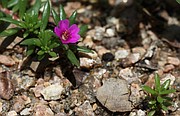Turn that rock pile into a fabulous garden
All it takes to turn that pile of rocks at the edge of your property into a beautiful showpiece, is a load of soil, perhaps a little rock-rearranging, and plants.
First, take a look at what you have: Sun, shade, or a combination; moist or dry site; water nearby. Then think about your vision — what are your preferences? Xeriscape (for a dry site only), cottage, formal or classic, herbs, grasses, Potted plants, ornamental veggies, focal points (growing or manmade). Consider individual plant needs, sun, shade, fertilizer, acid, alkaline, hardiness, and seasonal care (winter mulch, summer protection, watering, etc).
Now, get into the nitty-gritty or “hands-on” considerations: Continuity, scale, artful repetition, logical placement, balance/compatibility of stone and plant;
Rock gardens serve a multitude of purposes other than attractive landscaping. Eminently practical due to their natural hardiness, they are simple to maintain (thus saving considerable money), and often attract more birds and beneficial insects to the garden.
If you’re considering a natural look for an existing rocky site, consider utilizing what you already have: Look for natural wildlife plantings such as small trees (Mt. Ash, Rocky Mt. maple, Quaking aspen, Juniper, etc.), native vegetation and flowers, such as wild roses. Select your new plants accordingly, utilizing what’s already there. A mingling of wild/native and domestic plants can be beautiful and effective.
A lovely woodland theme could include Hosta, Heuchera (Coral bells), ferns (Sword, Lady, Maidenhair, and others, trailing vines like honeysuckle, Clematis, Dewberry (Rubus), delicate Sweet Woodruff, or perhaps Vinca minor (Periwinkle) evergreen and providing lush beauty. Intersperse with tall and beautiful Monkshood, Foxglove, Larkspur, Valerian, Betony, and/or Lobelia, tucked into spaces between rocks. Border it all with lower growers, such as Bleeding heart, Columbine, Lily of the valley, primulas, dwarf Iris, bulbs of dwarf Tulips, etc., Forget-me-nots, and wild Violets.
Consider seasonal coloration, layering, and more. A fall-colored golden-leaved quaking aspen (Populus tremuloides) fronted by a brilliant red burning bush (Euonymus) or red-twigged osier dogwood make for glorious autumn drama.
Or consider any of the currants (Ribes): Red-flowering, blood currant, etc. All currants have beautiful drooping flower clusters in shades of red or pink, sometimes white — looking like mini-fuchsias, joined later by the foliage, and then setting into the fruit which can be red or black.
Choose your own possibilities, considering what you already have, then mix and match these suggestions for your own all-season beauty. By the way, if your rock pile is fairly close to the house, enlarge the berry plantings and include garden items! Clumps of parsley (also a butterfly attractant), ornamental kale, varied sages, rhubarb, colorful rainbow chard, and pot-ted basil and rosemary for edible charm. Why not consider using wild or domestic strawberries as ground cover? Share them with the birds.
If you have that rare (in our area) Xeriscape habitat, intersperse your rocks with clumps or pots of plants such as Sedum, succulents like Hens/chicks and Portulaca (moss rose), Snow-in-summer, Baby’s breath, Goldenrod, bright red Oriental poppies, trailing Nasturtiums, Big grasses, Beargrass, Lavender, Heaths and Heathers — ad infinitum. And you thought that pile of rocks was just a pile of rocks.
And now a few gardening thoughts and tips:
Bare root 'no no'
I have always recommended buying plants at area nurseries and greenhouses. I do realize, however, that once in a while something takes our eye in a catalog that is perhaps rare or not available locally.
But there are precautions: As you’re aware by now, always check the Zone and don’t buy anything over Zone 5. Zones 3 and 4 are better yet, but it’s your dime.
The second precaution is to find out how they’re packaged. Pots are best, plugs acceptable, but bare-root is a real danger, especially in smaller plants. Many years ago, I foolishly ordered a Ligularia from a well-known garden, not realizing it would be shipped bare-root.
The wispy, fragile little dried thing that was sent to me never had a chance. I moistened it well, direct-planted it where I wanted it (in rich loam/potting soil mix), and tended it carefully — but it never got over the shock. It had probably been pulled
from its warm, sun-drenched S. Carolina soil, never expecting to be replanted in cold North Idaho conditions and that’s the end of the story.
Mistakes, I believe, are what make us better gardeners. Legendary English gardener Gertrude Jekyll, quoted in a small compendium of articles from her many books (”The Gardener’s Essential Gertrude Jekyll’), owed much of her garden design success to having begun her career as an artist.
Gardens as paintings
Ever after, she said she planned her gardens as “paintings.” She looked at each space, “saw” the garden in her mind, drew the design on paper, then determined where the variety of colors and shapes she wanted had to be placed to complement each other.
In all her “schemes” — whether small, intimate spaces; retreats; great, flowing florascapes, or long borders (at which she excelled), she began with that first step, then selected the right plants for the individual ecosystem and ground layout, with much thought also given to ongoing bloom and color through the seasons. That, of course, is what we ornamental gardeners try to do, and her efforts serve to inspire and teach us what to look for.
But there is yet another danger: As we artfully draw and “name” our plant circles on our butcher paper, striving for a comprehensive pattern, we must be careful not to create a contrived, artificial, or studied look. Think of the natural hodgepodge of nature, improve on it with a little guidance, but strive for a pleasing mix of shape, complementary color, and textures that join together in a grouping that looks like they’re all “where they belong.”
Miss Jekyll was able to achieve this success but admitted it was a while in coming. The desire to create a perfect canvas with no flaws has no place in nature, where surprises frequently happen. When a clump of Eryngium (Sea Holly) appeared out of nowhere, she was nonplussed and annoyed at first, but then realized that it had insinuated itself where it “wanted to be”
and it was a sort of revelation for her.
She not only left it where it was, but began to use similar “surprises” of her own on occasion — popping an unmatching single ruffled Hollyhock among artfully arranged lavenders and lilies, for instance, or a splash of white Shasta daisies batting their yellow eyes at a sober yellow-flowered Santolina.
But it must be only once because when people start expecting it, it’s no longer unique. Too, Miss Jekyll used these rare little flirtations in a serendipitous — rather than shocking — manner. Her whole gardening credo was always harmony.
(Editor’s note: For many years, Valle Novak has written gardening and cooking columns for the Daily Bee. “Weekend Gardener” and “Country Chef” became renowned for their humor, information, and common sense advice on how to do everything from planting to cooking. While she recently retired, she has shared a number of columns to delight her many fans. This is one such column and was originally published on February 2010.)





